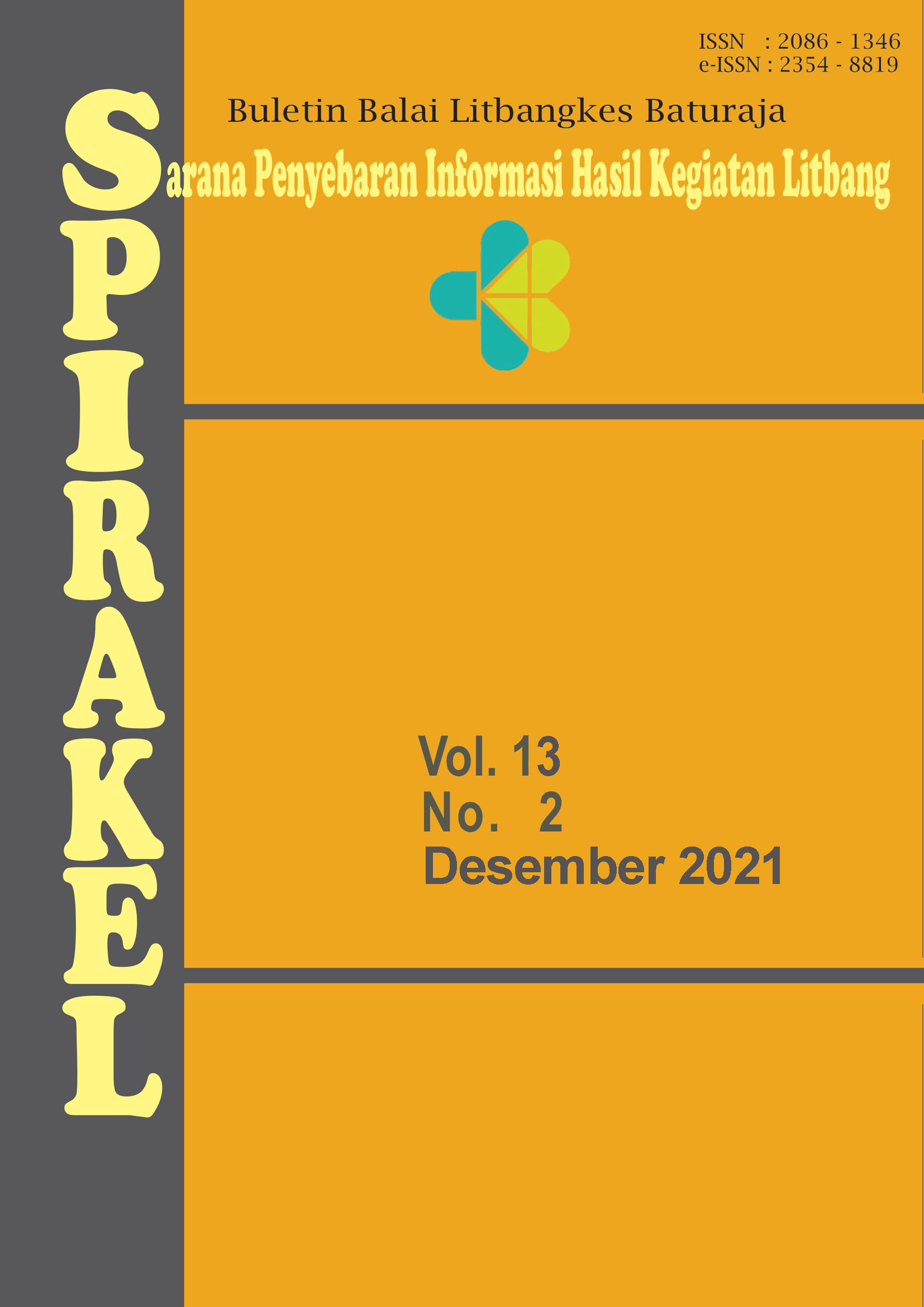PENGARUH SALINITAS TERHADAP PERKEMBANGAN STADIUM AKUATIK Aedes aegypti DI LABORATORIUM
Abstract
Aedes aegypti is known as the species of mosquito that breeds in fresh water, but due to the nature of adaptive this species found in habitats containing salt. This laboratory experiment aims to find out how different concentration of salinity will affect aquatic stages of Aedes aegypti. Salinity concentrations or treatment used in this study were 0‰, 2‰, 4‰, 6‰, 8‰ and 10‰ with five replicates. The observed parameters is the number of hatched eggs and number of surviving larvae or pupa after exposed to media containing salt. The results show that salinity influence both the number of hatced eggs and surviving larvae or pupae. There were decrease of number of hatched eggs and also the surviving larva or pupa as salinity increase. Analysis of variance showed significant relationship between salinity and the number of larvae or pupae survived but not with number of hatched eggs. Dengue vector adaptation against salinity become a phenomenon that needs to be examined and related to the spread of vector in habitats containing salt as well as transmission of the virus.
References
World Health Organization. Mosquito-Borne Diseases. https://www.who.int/neglected_diseases/vector_ecology/mosquito-borne-diseases/en/. Accessed February 2, 2019.
Myint KSA. Detecting Emerging Vector-Borne zoonotic pathogens in Indonesia. Jakarta: Alertasia Foundation; 2015.
CDC Atlanta. Mosquito life cycle. https://www.cdc.gov/dengue/resources/factsheets/mosquitolifecyclefinal.pdf. Accessed March 16, 2019.
Riandi MU, Hadi UK, Soviana S. Karakteristik habitat dan keberadaan larva Aedes spp. pada wilayah kasus demam berdarah dengue tertinggi dan terendah di Kota Tasikmalaya. ASPIRATOR - J Vector-borne Dis Stud. 2018; 9(1).
Madushika KKWT, Dayananda PD, Fernando HSD, et al. High salinity tolerance of Aedes to breed in Brackish waters around the Negombo Estuary. In: Proceedings of The International Forestry and Environment Symposium. Sri Lanka; 2016.
Sayono S. Pertumbuhan larva Aedes aegypti pada air tercemar. J Kesehatan Masyarakat. 2011; 1(January 2011):1-9.
Sudarmaja IM, Mardihusodo SJ. Pemilihan tempat bertelur nyamuk Aedes aegypti pada air limbah rumah tangga di laboratorium. J Vet. 2009; 10(4):205-207.
Setyaningrum E, Murwani S, Rosa S, Andananta K. Studi ekologi perindukan nyamuk vektor malaria di Desa Way Muli, Kecamatan Rajabasa Lampung Selatan. In: Seminar Pengabdian Masyarakat, Universitas Lampung. Universitas Lampung; 2008.
Karesh WB, Dobson A, Lloyd-Smith JO, et al. Ecology of zoonoses: Natural and unnatural histories. Lancet. 2012; 380(9857):1936-1945.
Martine G, McGranahan G, Montgomery M, Fernández-Castilla R. The New Global Frontier: Urbanization, Poverty and Environment in the 21st Century.; 2012.
Putra AD, Handayani W. Kajian Bentuk Adaptasi Terhadap Banjir Dan Rob Berdasarkan Karakteristik Wilayah Dan Aktivitas Di Kelurahan Tanjung Mas. Jurnak Tek PWK. 2013;2(3):786-796.
Nova MKS, Misbah NM. Analisis Salinitas dan Suhu Air Laut Terhadap Laju Korosi Baja A36 Pada Pengelasan SMAW. jurnal Tekhnik ITS.2012;1(1).
Clark TM. PH Tolerances and Regulatory Abilities of Freshwater and Euryhaline Aedine Mosquito Larvae. J Exp Biol. 2004;207(13):2297-2304.
McGinnis KM, Brust RA. Effect of different sea salt concentrations and temperatures on larval development of Aedes togoi (Diptera: Culicidae) from British Columbia. Environ Entomol. 2015; 12(5):1406-1411.
Bradley T. Physiology of osmoregulation in mosquitoes. Annu Rev Entomol. 1987;32:439-462.
Kraemer MUG, Sinka ME, Duda K a, et al. The global distribution of The Arbovirus vectors and . Elife. 2015;4:1-18. .
Ekechukwu NE, Ekeh FN. Effects of sodium chloride concentrations on larvae and pupae of Aedes aegypti. Anim Res Int. 2011; 8(3):1467-1472.
De Brito Arduino M, Mucci LF, Serpa LLN, De Moura Rodrigues M. Effect of salinity on the behavior of Aedes aegypti populations from the Coast and Plateau of Southeastern Brazil. J Vector Borne Dis. 2015;52(1):79-87.
Surendran SN, Jude PJ, Thabothiny V, Raveendran S, Ramasamy R. Pre-imaginal development of Aedes aegypti in Brackish and fresh water urban domestic wells in Sri Lanka . J Vector Ecol. 2012; 37(2):471-473.



